The ups and downs
How to tackle rising and falling water in spring
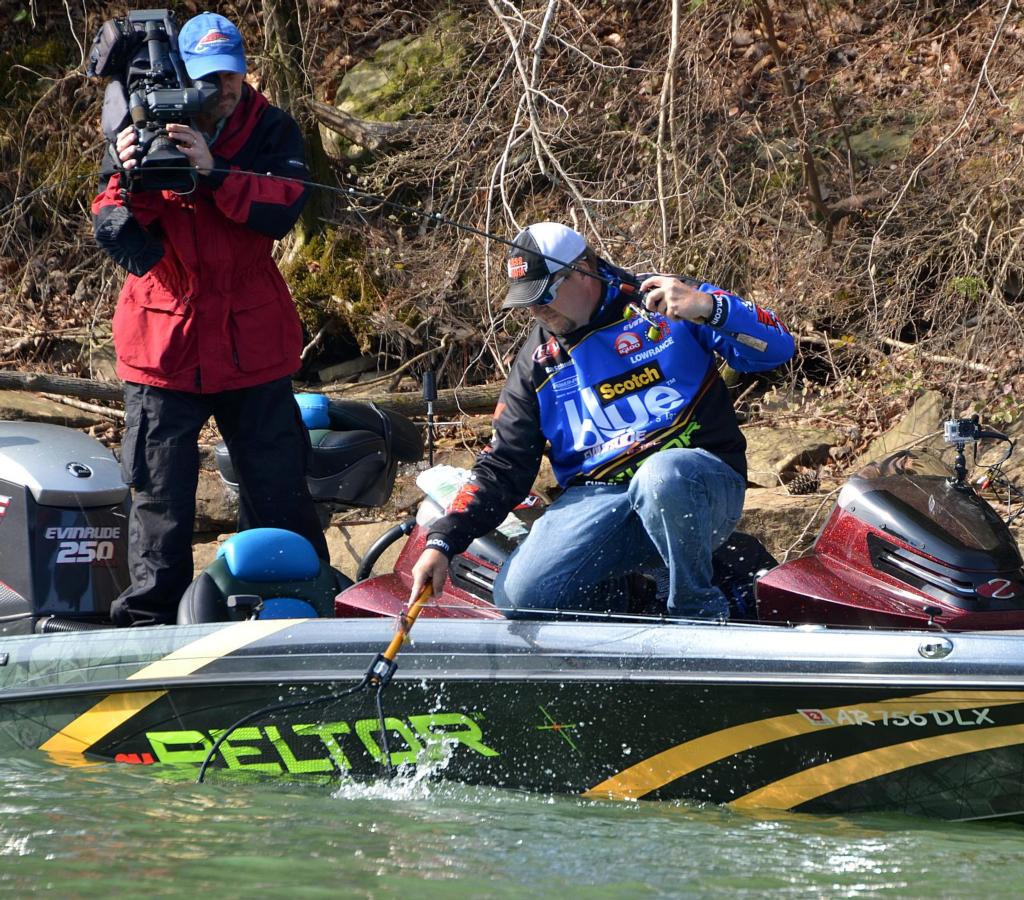
(Editor’s note: This article originally appeared in the 2013 March issue of Bass Fishing magazine. To read more compelling articles from Bass Fishing magazine each month, become an FLW subscriber member. If you’d like to sign up for a digital subscription to access articles online, click here).
Ray Scheide just knew.
Sitting outside a small cove on the first morning of practice for the 2009 Walmart FLW Tour event at Beaver Lake, the 3M Scotch Tape and Peltor Brands pro from Dover, Ark., tried to peer to the back of the cove. Had the water been at a normal level, his line of sight would have been clear. Instead, it was blocked by a “logjam” of junk collected between flooded buck brush.
“Growing up in Oklahoma, I’ve seen that scenario hundreds of times,” Scheide says. “I knew exactly what to do.”
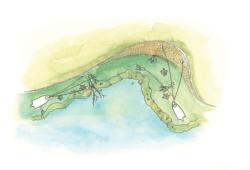 A week later, Scheide proved that his assessment was correct. He won the tournament by busting through the flooded brush and flipping “sawdust” – floating mats of sticks and leaf litter.
A week later, Scheide proved that his assessment was correct. He won the tournament by busting through the flooded brush and flipping “sawdust” – floating mats of sticks and leaf litter.
Unfortunately, few anglers are as confident as Scheide when it comes to rising spring water levels (or stable, high water or falling water, for that matter). Yet, it’s something reservoir anglers have to deal with nearly every year.
We spoke with Scheide and other top pros with the know-how and confidence in these roller-coaster scenarios, and found out it’s all about how you ride the fluctuations of rising, high-and-stable, and falling waters.
Rising water
So what exactly did Scheide know when he saw the water rising on Beaver Lake? He knew the bass were going to be crashing the bank, and he does mean the bank.
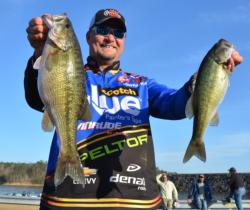 “Rising water means new cover, and that sends bass rushing to the bank,” Scheide says. “The thing with that tournament was that guys would quit fishing when they got to the part that was choked off with debris; they weren’t fighting back through it to get to the stuff close to the bank. I did, and that’s where the fish were.”
“Rising water means new cover, and that sends bass rushing to the bank,” Scheide says. “The thing with that tournament was that guys would quit fishing when they got to the part that was choked off with debris; they weren’t fighting back through it to get to the stuff close to the bank. I did, and that’s where the fish were.”
This can often be tough fishing; a lot of effort for 30 casts in the back of a flooding cove and maybe a fish or two. But when executed right, it’s good, consistent fishing with the potential for big payoffs.
The setting: To maximize his efforts, Scheide targets small to midsized pockets with steep banks of 45 degrees or steeper. The reason: The water can’t spread out as far, so once he gets to the back of such pockets, there are fewer targets for the bass to hang around.
“The fish will get in those large, flat stretches of cover, too,” Scheide says. “But it’s hard to pinpoint them in that much cover.”
The technique: When fish start crashing shallow, flooding cover, they’re typically aggressive. In that case, Scheide targets the backside of cover (the side that faces the shore) with moving lures such as soft-plastic jerkbaits, weedless paddle-tail swimbaits or hollow-bodied frogs.
In the Beaver Lake event, the fish weren’t as aggressive, so Scheide did a lot of flipping, targeting the backsides of bushes with a Berkley PowerBait Chigger Craw behind a 5/16-ounce weight.
“Always keep a punching weight handy, too,” Scheide says. “Those logjams of debris can hold fish just like the brush can.”
High, stable water
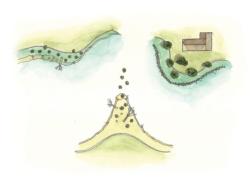 At some point, every reservoir’s water level stops rising. When it does, it transitions from “flooding” to “flooded,” and the fish take notice. So, too, should anglers.
At some point, every reservoir’s water level stops rising. When it does, it transitions from “flooding” to “flooded,” and the fish take notice. So, too, should anglers.
“When the water is rising, the fishing can be easy because the fish are going to the shallowest cover, and there’s only so much of it because the water has only reached so far,” says Chevy pro Jay Yelas. “But once the lake levels off and just becomes `high,’ there’s usually so much cover in the water that trying to fish it all can be like trying to find a needle in a haystack.”
The key now becomes whittling down the haystack to make finding the needles easier. To do that, Yelas seeks out isolated cover.
The setting: Each high-water scenario is different from the next, but in all of them there will be edges and isolated cover that become focal points for bass.
In a normal pocket, the edge might be a break in the expanse of flooded brush. If there is a mile-long stretch of brush that ends near a bluff wall, that end near the bluff becomes the edge. If the high water has reached into a person’s backyard, it will be the edges created by the tree lines meeting the lawn.
“Basically, you’re looking for things that stick out to narrow down the cover,” Yelas says. “I’ve heard of tournaments that were won in flooded parks where the guys were targeting picnic tables. Those tables represent isolated pieces of cover that concentrate fish when they could be anywhere.”
There is one piece of cover that Yelas says rarely pays off in high water: docks. He rarely targets them in high water.
The technique: With so much cover, this isn’t the time to sit and pick it apart piece by piece. This is a time to run and gun.
“You’re usually fishing in water that’s still 1 to 3 feet,” Yelas says. “The fish that are up there aren’t bashful. They’re usually aggressive.”
Spinnerbaits, square-bill crankbaits and vibrating jigs are some of Yelas’ favorites, as they all put out a lot of vibration (a plus in the normally dirty high water), and they come through cover well.
“You don’t necessarily have to hit the cover, but getting close is always good,” Yelas says. “You really want to work those edges, and you want to work a lot of them.”
Falling water
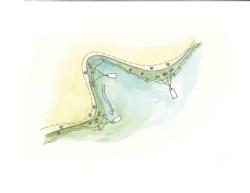 It was Sir Isaac Newton who famously noted that what goes up must come down. He was referring to his law of universal gravitation, but the same is true for spring water levels. They don’t stay high forever, and eventually they’re going to start receding to normal pool.
It was Sir Isaac Newton who famously noted that what goes up must come down. He was referring to his law of universal gravitation, but the same is true for spring water levels. They don’t stay high forever, and eventually they’re going to start receding to normal pool.
That means the shallow cover the bass had grown accustomed to will again be on dry land – or nearly so – and falling water will force fish to find new homes in their old digs. They’re not in any hurry.
“The bass are going to try and stay in that shallow cover as long as they can,” says Harrison, Ark., pro Robbie Dodson. “I’ve seen bass that had their backs sticking out of the water because they didn’t want to leave. But eventually, they have to leave.”
When they do, the remaining water often funnels the fish. You just have to find the funnel, as Dodson did when he won the 2012 EverStart Series Central Division event at Bull Shoals. Dodson’s tip is to follow the water. More specifically, he follows what cover is still submerged at any given time.
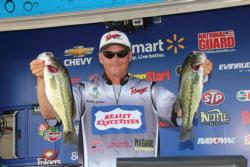 The setting: Dodson looks for the last bushes that are still fully submerged when the water first begins to fall, eventually working his way out to the last row of bushes where bass retreating from the falling water sometimes congregate. As he does, he also works his way out from the back of the coves to the first points outside of where the fish were hanging when the water was high.
The setting: Dodson looks for the last bushes that are still fully submerged when the water first begins to fall, eventually working his way out to the last row of bushes where bass retreating from the falling water sometimes congregate. As he does, he also works his way out from the back of the coves to the first points outside of where the fish were hanging when the water was high.
The technique: As when the water was rising, falling water reduces the amount of cover and makes it easier to pick apart each piece of cover quickly with a technique such as flipping.
As with the previous two scenarios, anytime you can find isolated cover or an area that restricts bass’ movements within the cover, your odds of connecting go up.
A large expanse of flooded timber might look great to both bass and anglers, but the odds of both finding each other in all of it are far slimmer than one bush off by itself.
Seasonal curveballs
While fish typically crash the banks when the water level gets high and fight to stay there even when the water recedes, there are certain elements that will change the game plan.
Obviously, being that it’s spring, the spawn is always a major factor. Yet, Chevy pro Jay Yelas believes it’s not as big of a factor as people think when the water is up.
“Bass will actually hold off on spawning if the water gets high,” Yelas says. “It’s like they know that the water is going to come down [and could leave the nests dry], and they wait for it.”
What they can’t hold off are cold fronts. Aside from making the fish sluggish, a harsh cold front can even pull the fish away from the bank completely. They won’t go far – usually to the first available cover in deeper water – but they can move. It’s just something to be aware of if the fish suddenly disappear for a day.
Dissecting a bush
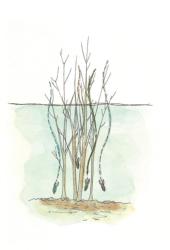 Many anglers don’t think about what side to flip to when they see a bush. They just flip to it.
Many anglers don’t think about what side to flip to when they see a bush. They just flip to it.
However, when pro Robbie Dodson won at the 2012 EverStart Series event at Bull Shoals, the water level was dropping steadily. On the first day of the tournament, the fish were still on the backside of the bushes he was fishing. By day two, the water had receded enough that it forced the bass into the heart of the bushes. Finally, on day three, with the water still falling, Dodson had to flip to the front of the bushes and hop his lure three or four times away from the bush in order to draw a strike. Doing anything different left him fishless.
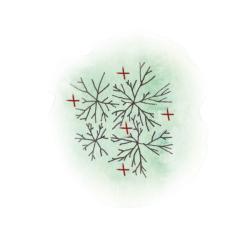 “The general rule is that when the water is rising, fish the backside of bushes,” Dodson says. “When it’s high and stable, fish the sides. And when it starts to fall, you fish the heart or the front of the bushes.”
“The general rule is that when the water is rising, fish the backside of bushes,” Dodson says. “When it’s high and stable, fish the sides. And when it starts to fall, you fish the heart or the front of the bushes.”